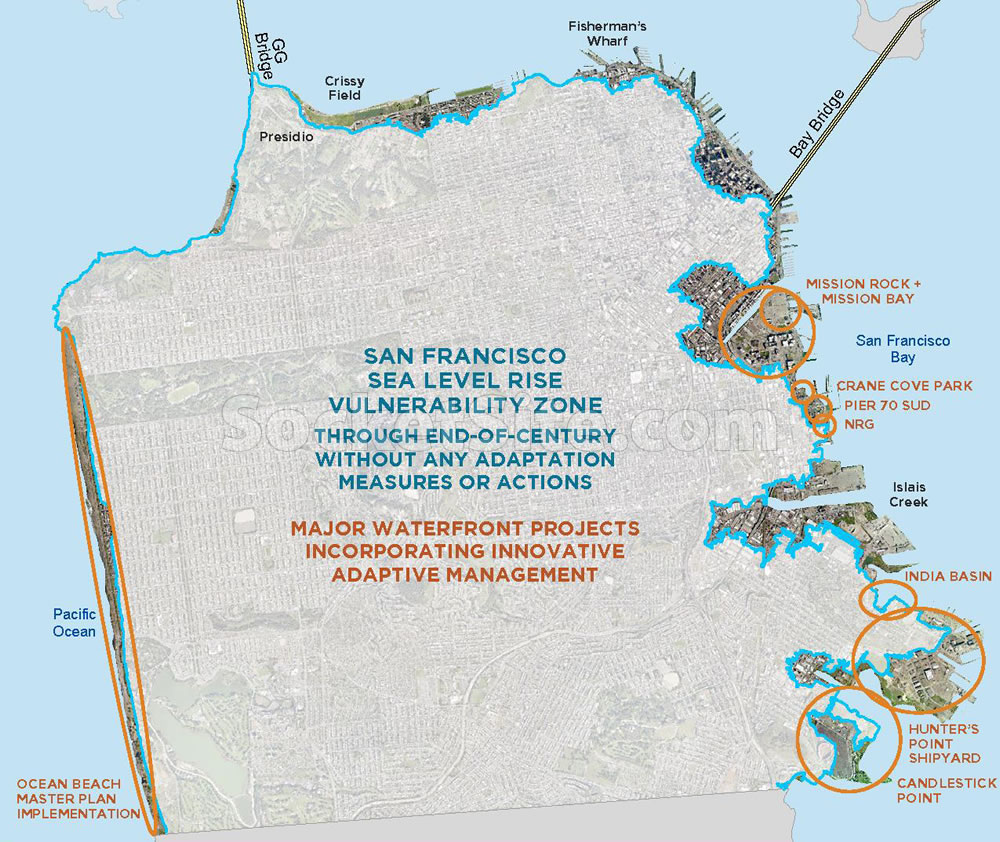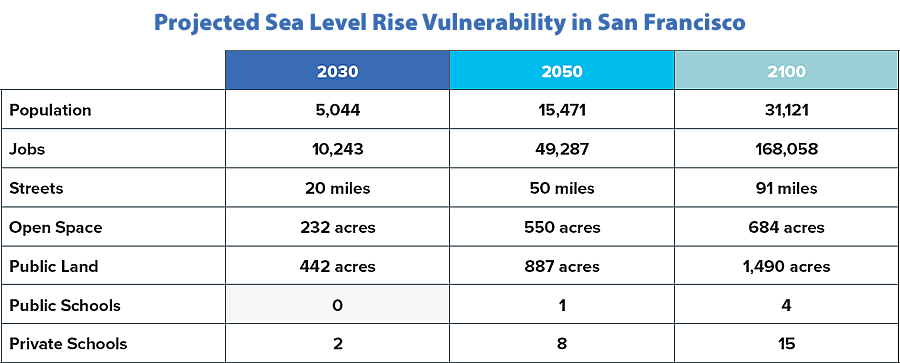Having already identified the areas of San Francisco that are most vulnerable to a rising sea, San Francisco’s Sea Level Rise Coordinating Committee (SLRCC), which is tasked with developing an interagency understanding of the impact of sea level rise on the city and developing a plan to mitigate its impacts, has now quantified the projected impacts as well.
While recently approved or future developments along San Francisco’s waterfront will be required to incorporate “innovative adaptive management” plans to mitigate the impact of the projected rise, on top of which storm surges typical raise the levels another 12 to 48 inches, there is a significant area of already developed neighborhoods and land that falls within the primary zone of vulnerability.
And with sea levels expected to rise between 36 and 66 inches by the end of this century, the zone of vulnerability could affect, if not displace, over 31,000 residents in San Francisco.
The projected sea level rise also threatens over 168,000 jobs, 91 miles of city streets, over 2,000 acres of public lands and open space and a total of 19 schools.
And with the city’s vulnerabilities and consequences having been assessed and slated to be presented to San Francisco’s Planning Commission this afternoon, the Sea Level Rise Coordinating Committee can now shift its focus to developing a plan, funding and implementation strategy for moving forward and minimizing the projected impact of sea level rise on San Francisco.


What about treasure Island?
It is easier to simply show it as submerged in the bay, so they don’t have to extend the map.
Oh, jeez, you’re right, what about Treasure Island!?
It might be worth mentioning that in addition to sea level rise, the streets in Mission Bay are sinking – unlike buildings with deep foundations that are probably holding steady.
At some point, sewers might be one leak away from being filled with water, as the water table rises.
Is there a specific example of this happening in Mission Bay? First I’m hearing of it.
There were substantial delays to the Public Safety building project on 3rd and China Basin street, because China Basin kept sinking.
Mission Bay Settles
Thanks for the link. Great read. I had noticed the worsening problem around Strata. I see poor Bimma Loft (furniture store) is finally giving its up. Their going out of business sign now includes “Open during construction.”
Need to surcharge all areas outside of the building perimeter, for those building with pile foundations to bedrock, otherwise you will have subsidence. Surcharge design can slow but not stop subsidence.
Come on, let’s look on the up-side: Chase Arena – or whatever its called in 2100 – will be able to offer door-to-door ferry service! Just in time for the Warriors 86th consecutive Finals appearance.
The salt water won’t be good for all those steel structures.
At least we’re allowed to look at the problem.
(In Florida I think scientists are barred from the words ‘global warming’, because ignoring this problem will make it go away, especially in Florida.)
Check out an piece call “Heaven or High Water: Selling Miami’s Last 50 Years”. That entire state is in the most willfully ignorant kind of denial. They already have sunny day flooding and just act like it doesn’t matter or mean anything.
Venice, one of the best cities in the world, has had daily flooding for the past 1500 years. Most people would gladly trade the Piazza San Marco for Fishermans wharf or dry feet. 🙂
The population of the islands of Venice is way lower and the corresponding infrastructure vastly less critical. And they built large, complex surge protection at the entrances to the lagoon. They didn’t just accept it.
Venice is worth more important to humanity than SFO or Oracle park – doesn’t matter how much those cost. I bet the rest of your family would say your old vw beetle with 4 kids in it is worth more than a Porshe with Steve Jobs and 4 old Sand Hill venture capilitalists (5) in it. Whether or not something is worth saving can’t be measure by $ alone.
SF doesn’t need a complex surge protection system. All this land on the map is man made fill. It used to be part of the SF Bay. Underwater by 10 feet. Just throw down some more dirt and raise it up more. May be a lot of dirt – buts it is not hard.
Yeah… that’s the point. People in Venice and that visit Venice don’t like that it floods and they didn’t just accept it getting worse without doing anything. The same thing is happening and will increasingly happen here.
Venice will no longer exist in fifty years.
What a pessimist. Its been there for 1500 years. Its going to be there for another 1500 years even if the Italians have to hire the Dutch to build a dike around it.
The Chart above outlining population and jobs is nice but the reality that this is about real estate, the value of the real estate versus the cost to rebuild the current sea wall and add sea walls.
Florida is funny thanks to those who put idealogy of science; the State of Florida, local governments via sales taxes and Miami are already spending massively on beach nourishment & shore protection, salt water intrusion and so forth due to sea level rise and the strengthening of storms. Put our head in the sand but make sure their is enough sand protecting our tourism trade, beach houses and condos and so forth.
You can pretty much say goodbye to ALL of our major airports in the Bay Area.
There’s no chance whatsoever that they won’t be protected by new and bigger seawalls.
Sierra Club and the no more fill in the Bay folks are going to have a field day with that.
Projects like that don’t require any filling in of the Bay.
SFO and OAK already raising their levees and seawalls to work through the rising sea level issue. Actually, Oakland Airport currently has a contract out to bid for the specific reason of raising their levees. As Anonymous notes, no more bay infill needed for current runway configurations and no way they are not raising existing seawalls.
The one thing that might not happen is for SFO to add infill to put some more space between and extend runways in order to mitigate delays during inclimate weather. Delays will only increase in time as SFO passenger and takeoffs/landings increase
Good added color there.
The proposal from years ago to build new runways out in the Bay to get the 3400′-4400′ runway separation needed for all-weather simultaneous takeoffs and landings went nowhere, and certainly won’t now. However, there are other technologies related to air traffic control and flight being developed and deployed that help reduce weather (i.e. fog) delays even for runway configurations like SFO. In 5-10 years, the minimum runway separation for low-visibility might be significantly reduced or eliminated altogether.
Balderdash, unless, of course, you’re implying SJC isn’t “major”.
The point of these kinds of papers, despite their false precision – which is probably even more amusing to the informed than it is comforting to the ignorant – isn’t to lay out THE solution as much as it is to inspire thinking toward one; and hopefully counteract false information…which seems to be abundant.
Thank you for calling out the false precision. Details like that fly over the heads of 98.324% of lay people .
And that percentage doubles if an ‘expert’ is quoted along with the numbers.
🙂
Trump is trying to drown California!
If this is true, how do banks justify long-terms loans for projects in the sea rise zones? A bank would not loan money for a building project that will be literally underwater in 11 years…supposedly.
Do mean a mortgage?
> a year is “long term” in GAAP speak, anything over five years might as well be consigned to the pages of ‘The Magazine of Fantasy & Science Fiction’ rather than the WSJ.
Banks absolutely account for climate change at a higher rate than they ever have before.
So do insurance companies!